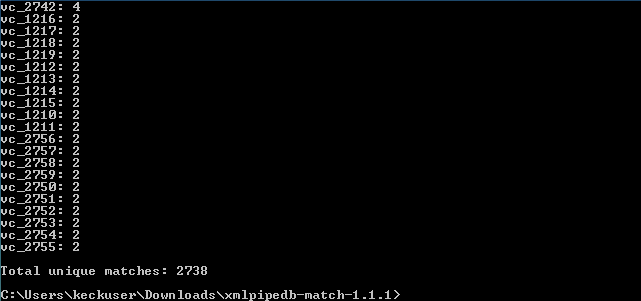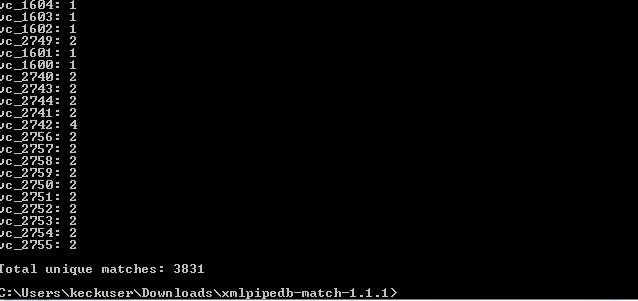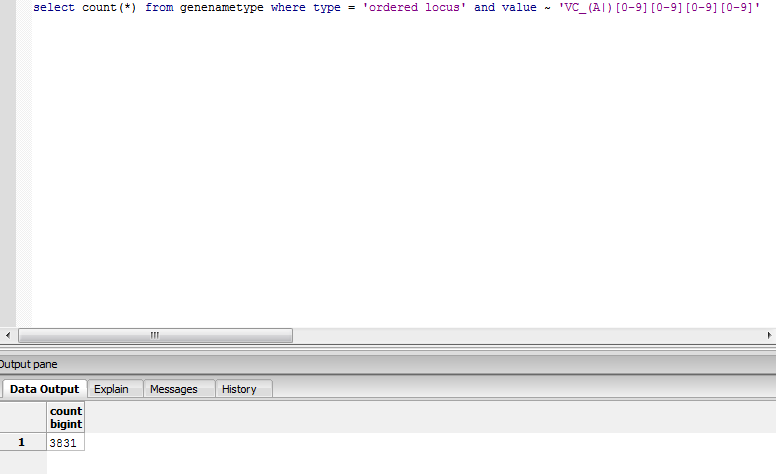Difference between revisions of "Kevinmcgee Week 9"
Kevinmcgee (Talk | contribs) (Added answers) |
Kevinmcgee (Talk | contribs) (uploaded go file) |
||
| Line 17: | Line 17: | ||
* Time taken to process: 14.78 minutes | * Time taken to process: 14.78 minutes | ||
| − | GOA filename: 46.V_cholerae_ATCC_39315_10_22_LM_KM.txt | + | GOA filename: [[file: 46.V_cholerae_ATCC_39315_10_22_LM_KM.txt]] |
* GOA version (News on [http://www.ebi.ac.uk/GOA/ this page] records past releases; current information can be found in the Last modified field on the [ftp://ftp.ebi.ac.uk/pub/databases/GO/goa/proteomes/ FTP site]): | * GOA version (News on [http://www.ebi.ac.uk/GOA/ this page] records past releases; current information can be found in the Last modified field on the [ftp://ftp.ebi.ac.uk/pub/databases/GO/goa/proteomes/ FTP site]): | ||
* Time taken to import: 0.16 minutes | * Time taken to import: 0.16 minutes | ||
Revision as of 18:50, 24 October 2013
Export Information
Version of GenMAPP Builder:2.0b70
Computer on which export was run: Last row of computer in the lab; second computer from the right when facing the front of the classroom.
Postgres Database name: Vibrio_cholerae_serotype_O1_10_22_LM_KM
UniProt XML filename:File:Vibrio cholerae serotype O1 10 22 LM KM.xml
- UniProt XML version (The version information can be found at the UniProt News Page):
- Time taken to import: 8.49 minutes
GO OBO-XML filename:File:Go daily-termdb.obo-10 22-LM-KM.xml.gz
- Direct Download from Wiki due to connectivity problems.
- GO OBO-XML version (The version information can be found in the file properties after the file downloaded from the GO Download page has been unzipped):
- Time taken to import:20.02 minutes
- Time taken to process: 14.78 minutes
GOA filename: File:46.V cholerae ATCC 39315 10 22 LM KM.txt
- GOA version (News on this page records past releases; current information can be found in the Last modified field on the FTP site):
- Time taken to import: 0.16 minutes
Name of .gdb file: Vc-Std_20131022_LM_KM-gmb2b70.gdb
- Time taken to export .gdb:
- Upload your file and link to it here.
Note: Export started around 11 am; ended at 3:19:06 pm.
File:Vc-Std 20131022 LM KM-gmb2b70.gdb
TallyEngine
Run the TallyEngine in GenMAPP Builder and record the number of records for UniProt and GO in the XML data and in the PostgreSQL databases (or you can upload and link to a screenshot of the results).
Using XMLPipeDB match to Validate the XML Results from the TallyEngine
Follow the instructions found on this page to run XMLPipeDB match.
Are your results the same as you got for the TallyEngine? Why or why not?
At first the match did not have the same results
After we added (A| ) to the command, we were able to get the same results for both the tally engine and the XMLpipe DB Match
Using SQL Queries to Validate the PostgreSQL Database Results from the TallyEngine
Follow the instructions on this page to query the PostgreSQL Database.
I was able to get a correct count on and SQL query as well
OriginalRowCounts Comparison
Within the .gdb file, look at the OriginalRowCounts table to see if the database has the expected tables with the expected number of records. Compare the tables and records with a benchmark .gdb file.
Benchmark .gdb file: (for the Week 9 Assignment, use the "Vc-Std_External_20101022.gdb" as your benchmark, downloadable from here.
Copy the OriginalRowCounts table and paste it here:
Table Rows
Info 1
Systems 30
Relations 18
Other 0
GeneOntologyTree 97982
GeneOntology 5556
UniProt-GOCount 3240
GeneOntologyCount 3239
UniProt-GeneOntology 20464
UniProt 3784
Pfam 2102
RefSeq 3403
PDB 223
InterPro 4349
OrderedLocusNames 3832
EMBL 228
UniProt-EMBL 5452
UniProt-OrderedLocusNames 3832
UniProt-PDB 319
UniProt-InterPro 10393
UniProt-RefSeq 3635
UniProt-Pfam 4648
RefSeq-Pfam 4145
RefSeq-InterPro 9241
RefSeq-PDB 234
RefSeq-OrderedLocusNames 3520
RefSeq-EMBL 3669
OrderedLocusNames-Pfam 4367
OrderedLocusNames-InterPro 9723
OrderedLocusNames-PDB 235
OrderedLocusNames-EMBL 4111
RefSeq-GeneOntology 18931
OrderedLocusNames-GeneOntology 20613
Note: There was one extra Ordered Locus name in the gdb file than there was in XML pipe DB Match or the Tally Engine.
Upon further inspection, we have found that this is because one of the Locus names was joined together with a slash mark.
This can be proven by going back into XMLpipeDB Match and accounting for the / in the command. The command shows one significant name with a slash in it
Visual Inspection
Perform visual inspection of individual tables to see if there are any problems.
- Look at the Systems table. Is there a date in the Date field for all gene ID systems present in the database?
- There is no date for the Gene ID's present
- Open the UniProt, RefSeq, and OrderedLocusNames tables. Scroll down through the table. Do all of the IDs look like they take the correct form for that type of ID?
- They all seem to be in the correct form
Note:
.gdb Use in GenMAPP
Note:
Putting a gene on the MAPP using the GeneFinder window
- Try a sample ID from each of the gene ID systems. Open the Backpage and see if all of the cross-referenced IDs that are supposed to be there are there.
Note:
Creating an Expression Dataset in the Expression Dataset Manager
- How many of the IDs were imported out of the total IDs in the microarray dataset? How many exceptions were there? Look in the EX.txt file and look at the error codes for the records that were not imported into the Expression Dataset. Do these represent IDs that were present in the UniProt XML, but were somehow not imported? or were they not present in the UniProt XML?
Note:
Coloring a MAPP with expression data
Note:
Running MAPPFinder
Note:
Compare Gene Database to Outside Resource
The OrderedLocusNames IDs in the exported Gene Database are derived from the UniProt XML. It is a good idea to check your list of OrderedLocusNames IDs to see how complete it is using the original source of the data (the sequencing organization, the MOD, etc.) Because UniProt is a protein database, it does not reference any non-protein genome features such as genes that code for functional RNAs, centromeres, telomeres, etc.
Note:




